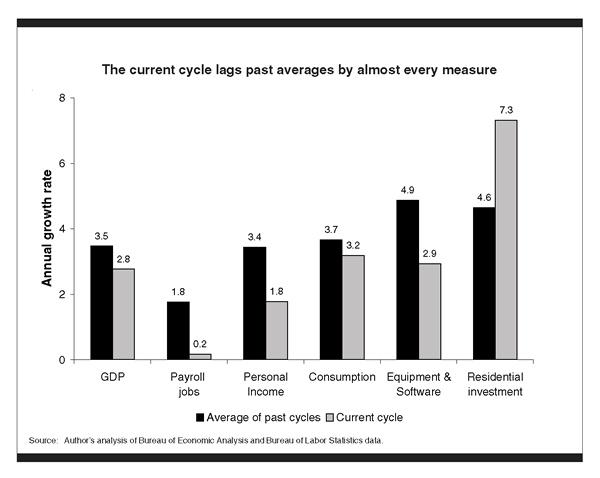See Snapshots Archive.
Snapshot for October 26, 2005.
Economy pays price for Bush’s tax cuts
Since 2001, changes in tax law have cost the federal government $929 billion, including $860 billion in direct cost and $69 billion in interest.1 Proponents of these tax cuts promised stronger economic gains than were typical of the past, but that did not occur.2 Unfortunately for most Americans, almost every broad measure of economic activity—GDP, jobs, personal income, and business investment, among others—has fared worse over the last four years than in past business cycles.

As the chart above indicates, there has been one bright spot in the economy—residential investment. But that sector has had a reduction in tax incentives because lower income tax rates reduce the value of deductions for mortgage interest and real estate taxes. For a person with a mortgage with $10,000 in interest, taxes are reduced by $3,500 with a 35% tax rate and by $3,000 with a 30% rate.
Even as tax cuts have failed to boost economic performance, they have reduced revenues substantially. In the recently completed fiscal year 2005, the cost of all the tax cuts passed since 2001 combined was $260 billion (of which $35 billion was interest), a sum that would wipe out most of last year’s unsustainable $317 billion deficit. If the tax cuts are extended and reasonable assumptions about future spending are accepted, the deficit will remain near 3% of GDP (or higher) indefinitely.3
As the Congress debates whether to enact new tax cuts or to extend expiring cuts, it should view claims of economic benefits with skepticism and recognize their substantial effects on the already excessive budget deficit. We would enhance the standard of living of most Americans in the future if the tax cuts for those with high income and wealth were allowed to expire.
For more details on Bush’s tax cuts and their effect on the economy, including an analysis that shows how the end of tax breaks did not reduce investment, see Lee Price’s EPI Briefing Paper, The Boom That Wasn’t—The economy has little to show for $860 billion in tax cuts.
This week’s Snapshot was written by EPI research director Lee Price. Research assistance was provided by David Ratner.
Notes:
1. Tax costs were estimated by the Joint Committee on Taxation and interest costs by the Center on Budget and Policy Priorities.
2. The Economic Policy Institute did a monthly analysis of the failure of the 2003 tax cuts to deliver the promised job gains on its jobwatch.org web site. It also preserved Council of Economic Advisers, Strengthening America’s Economy: The President’s Jobs and Growth Proposals, February 4, 2003 on its website after the CEA pulled it down (See http://www.jobwatch.org/creating/bkg/cea_on_bush_tax_cuts_20030204_macro_effects.pdf .)
3. Max Sawicky, “Red Ink Rising,” EPI Economic Snapshot, September 21, 2005, /content.cfm/webfeatures_snapshots_20050921
